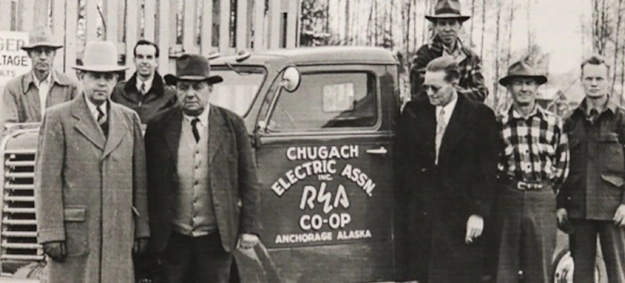Your Cooperative
Chugach Electric Association is headquartered in Anchorage, Alaska's largest city. Anchorage itself sits at the base of the Chugach Mountains. The word "Chugach" comes from an Alaska Native name, which the Russians recorded as "Chugatz" or "Tchougatskoi." In 1898, U.S. Army Capt. W.R. Abercrombie spelled the name "Chugatch" and applied it to the mountains.

Chugach is the largest member-owned electric cooperative in Alaska, serving over 90,000 members at over 113,000 metered locations. Its service territory extends from Anchorage to the northern Kenai Peninsula, westward to Tyonek and eastward to Whittier. Chugach originated as an Alaska electric cooperative in 1948, designed exclusively to serve its members.
Mission
We provide safe, reliable and affordable electricity through superior service and sustainable practices, powering the lives of our members.
Vision
Responsibly developing energy to build a clean, sustainable future for Alaska.
Values
Guided by our values of safety, accountability and sustainability, we are committed to serving our members, the community, and the Chugach team.
The Cooperative Philosophy
Chugach is a cooperative, formed to serve its member-owners. In many ways, cooperatives are like any other business; but in several important ways they're unique and different.
For more information on cooperatives please visit the National Rural Electric Cooperative Association (NRECA)
Cooperative Benefits
Mobile Application
Owned and democratically controlled by their members – the people who use the co-op’s services or buy its goods – not by outside investors; co-op members elect their board of directors from within the membership.
Mobile Application
Return surplus revenues (income over expenses and investment) to members proportionate to their use of the cooperative, not proportionate to their “investment” or ownership share. This is Chugach’s “capital credits” program.
Mobile Application
Motivated by service, not profit – to meet their members' needs for affordable and high quality goods or services.
Mobile Application
Exist solely to serve their members.
Mobile Application
There are about 950 electric cooperatives across the country.
Mobile Application
Other businesses can be organized as cooperatives. There are a number of telephone cooperatives in the country. Other examples of cooperatives include REI and Sunkist.



History of Cooperatives
| 1844 | The “modern cooperative era,” when the Rochdale Equitable Pioneers Society was established in Rochdale, England. Its members documented the principles by which they would operate their food cooperative, implementing the central tenets around which cooperatives are structured today. |
| Late 1900’s | Cooperatives sprung up sporadically in America, particularly in times of economic hardship. |
| 1922 | Congress passed the Capper-Volstead Act, allowing farmers to collectively market products without being held in violation of the nation's anti-trust laws. |
| 1929 | Farm Credit Administration is established. |
| 1934 | The National Credit Union Administration is established. |
| 1936 | The Rural Electrification Administration is established. |
| 1978 | The National Cooperative Bank was established under the National Consumer Cooperative Bank Act. |
| Today | The bank's central function to this day is to stimulate economic growth and community development via an array of financial services for cooperatives. |
Cooperative
Principles
Voluntary and Open Membership
Democratic Member Control
Members' Economic Participation
Autonomy and Independence
Education, Training, and Information
Cooperation Among Cooperatives
Concern for Community


